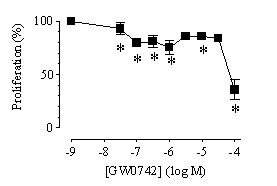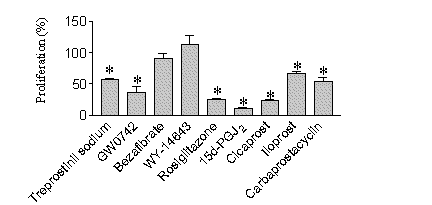| pA2 online © Copyright 2004 The British Pharmacological Society |
048P
University of Bath Summer Meeting July 2004 |
|
Anti-proliferative role for PPAR
|
|
Peroxisome proliferator activated receptors (PPARs) are a family of 3 nuclear receptors. PPAR![]() is ubiquitously expressed and is thought to be involved in the proliferation of vascular smooth muscle cells, pre-adipocyte cells, and cancer cells (Zhang et al, 2002). Little is known about the endogenous ligands for PPAR
is ubiquitously expressed and is thought to be involved in the proliferation of vascular smooth muscle cells, pre-adipocyte cells, and cancer cells (Zhang et al, 2002). Little is known about the endogenous ligands for PPAR![]() , although prostacyclin and some of its mimetics are known activators (Lim and Dey, 2002). Prostacyclin is cytoprotective in some organ systems including the gastrointestinal tract and the pulmonary circulation where its effects are thought to be mediated by cell surface IP receptors. However, we have previously shown that the prostacyclin mimetic, treprostinil sodium (gift from United Therapeutics Corp.) which is currently used in the treatment of pulmonary hypertension, inhibits murine pulmonary cell growth via a PPAR
, although prostacyclin and some of its mimetics are known activators (Lim and Dey, 2002). Prostacyclin is cytoprotective in some organ systems including the gastrointestinal tract and the pulmonary circulation where its effects are thought to be mediated by cell surface IP receptors. However, we have previously shown that the prostacyclin mimetic, treprostinil sodium (gift from United Therapeutics Corp.) which is currently used in the treatment of pulmonary hypertension, inhibits murine pulmonary cell growth via a PPAR![]() -dependent pathway (Ali et al, 2003). The function of PPAR receptors differ between species, here we have investigated the effects of treprostinil sodium and selective ligands for PPAR
-dependent pathway (Ali et al, 2003). The function of PPAR receptors differ between species, here we have investigated the effects of treprostinil sodium and selective ligands for PPAR![]() , PPAR
, PPAR![]() and PPAR
and PPAR![]() on the proliferation of human pulmonary fibroblasts.
on the proliferation of human pulmonary fibroblasts.
Primary cultures of human lung fibroblasts were purchased from ATCC, seeded at 20,000 cells/ml and kept in DMEM with 10% FCS. At 40% confluence cells were growth arrested (no FCS) for 24 h, after which time drugs were added. 4 h later FCS was returned to cells at final concentration of 3%. Cells were then incubated (5% CO2 in air, 37 °C) for 5 days and proliferation was quantified using a fluorescence assay (CYQUANT; Cambridge Bioscience). For western blots, cell extracts were probed using primary antibodies specific to PPAR![]() (Mr approximately 50kDa).
(Mr approximately 50kDa).
A

B

C
![]()
Figure 1. Effects of (A) GW0742 or (B) various PPAR ligands (all 10 -4 M) on proliferation of human lung fibroblasts. (C) Western blot showing expression of PPAR![]() in human lung cells. Proliferation was calculated as % growth induced by FCS. Data is mean ± s.e.m for n=3-9. *p<0.05; one sample t-test.
in human lung cells. Proliferation was calculated as % growth induced by FCS. Data is mean ± s.e.m for n=3-9. *p<0.05; one sample t-test.
Human lung fibroblasts expressed PPAR![]() and the selective PPAR
and the selective PPAR![]() ligand GW0742 (gift from G.S.K.) as well as treprostinil sodium, which inhibits proliferation in murine cells via a PPAR
ligand GW0742 (gift from G.S.K.) as well as treprostinil sodium, which inhibits proliferation in murine cells via a PPAR![]() dependent pathway, inhibited proliferation of human lung fibroblasts. PPAR
dependent pathway, inhibited proliferation of human lung fibroblasts. PPAR![]() ligands (rosiglitazone and 15d-PGJ2), but not the PPAR
ligands (rosiglitazone and 15d-PGJ2), but not the PPAR![]() ligand WY-14643 also inhibited proliferation. The mixed PPAR
ligand WY-14643 also inhibited proliferation. The mixed PPAR![]() /PPAR
/PPAR![]() ligand bezafibrate had no effect on proliferation. Finally, cicaprost, iloprost and carbaprostacyclin, which are ligands for PPAR
ligand bezafibrate had no effect on proliferation. Finally, cicaprost, iloprost and carbaprostacyclin, which are ligands for PPAR![]() in some cells inhibited proliferation of lung fibroblasts. This data suggests that PPAR
in some cells inhibited proliferation of lung fibroblasts. This data suggests that PPAR![]() is a therapeutic target for the treatment of human lung disease, particularly those, such as pulmonary hypertension, where remodelling contributes to symptoms.
is a therapeutic target for the treatment of human lung disease, particularly those, such as pulmonary hypertension, where remodelling contributes to symptoms.
Ali, FY et al (2003), Br J Pharmacol 1(4):P004
Lim, H and Dey, SK (2002), Endocrinology 143: 3207-3210
Zhang, J et al (2002), J Biol Chem 277(13): 11505-11512
This work was funded by the Joint Research Board of St Bartholomew’s Hospital, London